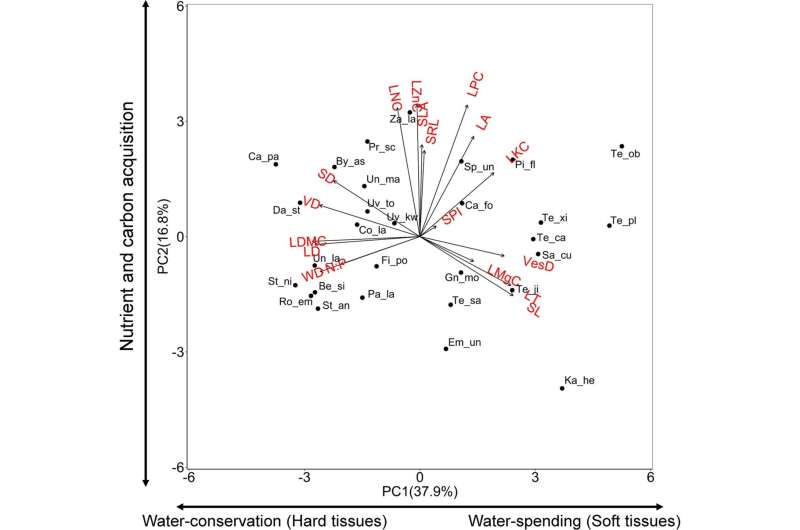Plant functional traits may better explain liana species distributions

Plant functional traits are morphological, physiological or phenological properties that affect plant growth, survival, and reproduction. They hold the promise to explain plant species distribution patterns. However, few studies have linked multiple traits to multiple niche dimensions (i.e., light, water, and nutrients).
In a study published in Oecologia, researchers from the Xishuangbanna Tropical Botanical Garden (XTBG) evaluated 18 leaf, stem, and root traits from 29 dominant liana species, and linked these to the light, water, and nutrient niche dimensions of the species in the 20-ha Xishuangbanna Forest Dynamics Plot in Yunnan Province, Southwest China.
The researchers asked how liana traits are associated, what plant strategies can be distinguished, and whether different traits shape different species niches.
Lianas showed two orthogonal trait spectra, a primary spectrum from tissue toughness and water conservation to tissue softness and rapid water acquisition, and a secondary spectrum in nutrient and carbon acquisition.
Liana species with more acquisitive trait values occupied higher light and nutrient resource niches, but different traits were important for different niche dimensions. Intriguingly, each spectrum partly reflects the conservative–acquisitive paradigm, but at the same time these two spectra are also independent from each other.
They found that different functional traits shaped different niche dimensions and that multivariate trait strategies also played a role in shaping liana distribution. This indicates that liana species with more acquisitive trait values (softer tissues, greater water use) can take advantage of these conditions and dominate high soil resource niches.
Moreover, they found that species niche is determined by the underlying components (i.e., individual traits) instead of plant strategies (i.e., overall trait syndromes).
"Traits, instead of local plant abundance, may therefore better explain species distributions and their presence along gradients of resource availability," said Zhang Jiaolin, principal investigator of the study.
More information: Qi Liu et al, Traits, strategies, and niches of liana species in a tropical seasonal rainforest, Oecologia (2021). DOI: 10.1007/s00442-021-04937-4
Journal information: Oecologia
Provided by Chinese Academy of Sciences




















